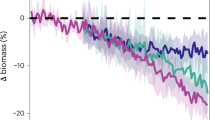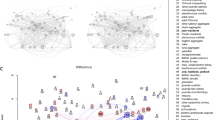Abstract
To understand relationships within food webs in the sea, with an eye to predicting and perhaps ultimately improving the efficiency of the production of commercially important species, we must understand the energetics of the lower elements of the food web. Energy flow more accurately represents the significance of a species in a community than either the numbers or the biomass of the species1. Euphausiids (class Crustacea) are pelagic filter-feeders of world-wide distribution which serve as forage for a wide variety of marine animals, including whales2 and salmon3. Euphausia pacifica Hansen, the principal species in the North Pacific, often represents the largest biomass of the macroplankton in the subarctic and transitional water masses4. The species is a vertical migrant, inhabiting depths of roughly 100–500 m during the day and ascending to surface waters at night4. It is exposed to water temperatures of about 5°–15° C off Oregon (depending upon season and depth of migration); 10° C is the approximate average5. Day length varies off Oregon from about 8 h in winter to 16 h in summer, so that the time spent in waters of different temperature varies seasonally6.
This is a preview of subscription content, access via your institution
Access options
Subscribe to this journal
Receive 51 print issues and online access
$199.00 per year
only $3.90 per issue
Buy this article
- Purchase on Springer Link
- Instant access to full article PDF
Prices may be subject to local taxes which are calculated during checkout
Similar content being viewed by others
References
Odum, E. P., and Smalley, A. E., Proc. US Nat. Acad. Sci., 45, 617 (1959).
Boden, B. P., Johnson, M. W., and Brinton, E., Bull. Scripps Inst. Oceanog., 6, 287 (1955).
Kujala, N. F., thesis, Oregon State Univ. (1966).
Brinton, E., Bull. Scripps Inst. Oceanog., 8, 51 (1962).
Small, L. F., and Hebard, J. F., Limnol. Oceanog. (in the press).
Small, L. F., Hebard, J. F., and McIntire, C. D., Nature, 211, 1210 (1966).
Smalley, A. E., Ecology, 41, 672 (1960).
Gilson, W. E., Science, 141, 531 (1963).
Richman, S., Ecol. Monogr., 28, 273 (1958).
Lasker, R., J. Fish. Res. Bd. of Canada, 23, 1291 (1966).
Ponomareva, L. A., Euphausiids of the North Pacific, their Distribution and Ecology, Akad. Nauk, SSSR, Inst. Okeanol., 1963 (translated by Israel Prog. Sci. Translations, Ltd., 1966).
Author information
Authors and Affiliations
Rights and permissions
About this article
Cite this article
SMALL, L. Energy Flow in Euphausia pacifica. Nature 215, 515–516 (1967). https://doi.org/10.1038/215515a0
Received:
Revised:
Published:
Issue Date:
DOI: https://doi.org/10.1038/215515a0
Comments
By submitting a comment you agree to abide by our Terms and Community Guidelines. If you find something abusive or that does not comply with our terms or guidelines please flag it as inappropriate.



